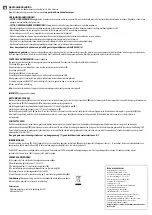
4
Owing to its variety of control possibilities digital technology provides enormous enjoy-
ment. You will learn a lot and if the layout is complcated and many trains are to run at
the same time you can use a computer to control it - this is not always so simple but can
be an enjoyable challenge.
Analogue and digital technology - the fundamentals
With analogue technology the speed of PIKO locos is controlled by the voltage (0 -
14V). This is achieved by a controller such as the PIKO Speed control #55003 (speed con-
trol with mains adapter) or the transformer with speed regulator #55002.
With this only one loco can be driven on a track at a time. If several locos are on the
same track, they will all travel at the same speed. If the tracks are isolated from one
another it is possible to drive several locos but it is then necessary to connect several
speed controllers to the tracks with appropriate switching and separate speed controller
for each of the locos that will be simultaneously moving.
With digital technology the entire layout operates with the same voltage (14V). In
order to control the individual locos a control centre is required which sends commands
(digital data) to the locos via the rails. So that these commands have an effect in the
locos each loco is fitted with a decoder, which receives the commands and converts
them i.e. decodes them, hence the name decoder.
Each loco is given an address. So that each loco knows when it is being ‘spoken to’,
each command from the control centre must be preceded by the loco’s address.
Provided the address is identical with the address of the loco it will know: ”watch out,
this command is for me.” Then the command is decoded, the loco decoder converts the
command to an analogue function and the loco moves faster, slower, switches on its
lights, whistles or stops.
Technical description: The control centre converts the voltage received from the mains
adapter to direct current. This is transmitted to the rails via an inverter and associated
electronic circuits at a frequency of 10 - 20 kHz.
This high frequency current is converted by the loco decoder to analogue DC current
tha powers the motor as soon as the relevant command arrives.
Содержание Digi 1
Страница 1: ...PIKO digital Manual...




































